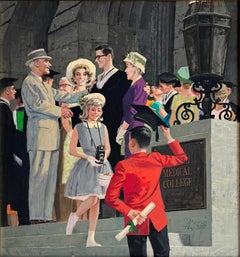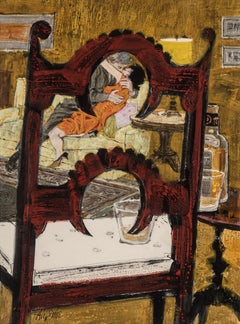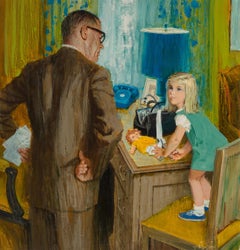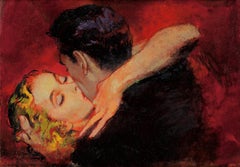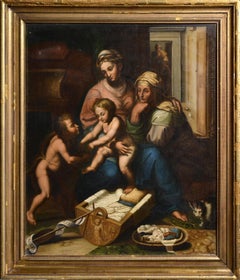Alex Ross Figurative Paintings
to
5
3
3
2
2
2
1
Overall Height
to
Overall Width
to
1
5
4
2
2
1
1
1
1
1
1
1
1
1
5
2
3
21
425
224
205
102
5
4
4
2
2
Artist: Alex Ross
Mid Century Golden Age of Illustration- Narrative Art - Norman Rockwell School
By Alex Ross
Located in Miami, FL
“Graduation Day” is emblematic of mid-century American Illustration.
But the real story of this storytelling work is that it embodies the lost art of portrait painting and graphic design.
Alex Ross borrows on the classical tradition and flaunts his skills as a narrative painter. In “Graduation Day”, he paints a complex composition involving at least thirteen portraits. The subjects are beautifully rendered and lit. They are set against a dark grey background and jump off the surface at the viewer. The composition is complexly designed. The future graduate in the red jacket engaging with a girl photographer is a compositional device that leads the viewer's eye to the main subject - a father congratulating his son on graduating from medical school. Creating art that relies on facial expressions and body gestures is a talent absent in contemporary art. Why? It’s very hard to do and takes years and training and practice to get it right. Despite Alex Ross's folksy subject matter, this work is a high example of naturalism and representation by an important member of the Golden Age of American Illustration.
Signed lower right
Born in the town of Dunfermline, Scotland, Alexander Sharpe Ross (1908-1990) moved with his family to Pittsburgh, Pennsylvania in 1911. After attending Carnegie Tech (now Carnegie Mellon University), Ross moved to New York and joined the Charles E. Cooper Studio, where he worked among such notable illustrators as Ward Brackett, Stevan Dohanos, J. Frederick Smith...
Category
1940s Alex Ross Figurative Paintings
Materials
Gouache
Voyeur chair. Romantic Couple Kissing and Embracing, Mid Century Illustration
By Alex Ross
Located in Miami, FL
Alexander Sharpe Ross gives us a voyeur view of an attractive couple kissing and embracing on a couch. Sharpe's radical use of composition is on ...
Category
1950s Romantic Alex Ross Figurative Paintings
Materials
Mixed Media, Oil, Gouache, Board
Caught! Young Girl uses Doctors Bag to Patch Up her Doll - Alexander Sharpe Ross
By Alex Ross
Located in Miami, FL
Alexander Sharpe Ross is an artist of consummate skill and wit. This painting captures a young girl in a doctor's office without permission. A p...
Category
1950s Realist Alex Ross Figurative Paintings
Materials
Oil, Canvas
How Sure Can You Be? McCall's Magazine Illustration of Loving Couple
By Alex Ross
Located in Miami, FL
Alexander Sharpe Ross - or Alex Ross. This work is a perfect artistic statement with every formal element in perfect harmony. It's a masterf...
Category
1940s Modern Alex Ross Figurative Paintings
Materials
Gouache
"The Embrace", Story Illustration for Cosmopolitan Magazine, August 1951
By Alex Ross
Located in Fort Washington, PA
Date: 1951
Medium: Gouache, Pen and Ink on Board
Dimensions: 12.75" x 18.00"
Signature: Signed Lower Left
The Embrace. Story illustration for "How About Tonight?" by John D. Hess, published in Cosmopolitan magazine...
Category
1950s Alex Ross Figurative Paintings
Materials
Board, Ink, Gouache, Pen
Related Items
Holy Family with St Elizabeth and Young John Baptist 19th century Oil Painting
Located in Stockholm, SE
This tender depiction of the Holy Family represents a subject which was central to Raphael's oeuvre. The painting is based on the famous panel by Giulio Romano, called Madonna della ...
Category
Late 19th Century Realist Alex Ross Figurative Paintings
Materials
Canvas, Wood, Oil
The Abduction of the Sabine Women , a Renaissance drawing by Biagio Pupini
Located in PARIS, FR
This vigorous drawing has long been attributed to Polidoro da Caravaggio: The Abduction of the Sabine Women is one of the scenes that Polidoro depicted between 1525 and 1527 on the façade of the Milesi Palazzo in Rome. However, the proximity to another drawing inspired by this same façade, kept at the Ecole des Beaux-Arts, and to other drawings inspired by Polidoro kept at the Musée du Louvre, leads us to propose an attribution to Biagio Pupini, a Bolognese artist whose life remains barely known, despite the abundant number of drawings attributed to him.
1. Biagio Pupini, a Bolognese artist in the light of the Roman Renaissance
The early life of Biagio Pupini, an important figure of the first half of the Cinquecento in Bologna - Vasari mentions him several times - is still poorly known. Neither his date of birth (probably around 1490-1495) nor his training are known. He is said to have been a pupil of Francesco Francia (1450 - 1517) and his name appears for the first time in 1511 in a contract with the painter Bagnacavallo (c. 1484 - 1542) for the frescoes of a church in Faenza. He then collaborated with Girolamo da Carpi, at San Michele in Bosco and at the villa of Belriguardo.
He must have gone to Rome for the first time with Bagnacavallo between 1511 and 1519. There he discovered the art of Raphael, with whom he might have worked, and that of Polidoro da Caravaggio. This first visit, and those that followed, were the occasion for an intense study of ancient and modern art, as illustrated by his abundant graphic production.
Polidoro da Caravaggio had a particular influence on the technique adopted by Pupini. Executed on coloured paper, his drawings generally combine pen, brown ink and wash with abundant highlights of white gouache, as in the drawing presented here.
2. The Abduction of the Sabine Women
Our drawing is an adaptation of a fresco painted between 1525 and 1527 by Polidoro da Caravaggio on the façade of the Milesi Palace in Rome. These painted façades were very famous from the moment they were painted and inspired many artists during their stay in Rome. These frescoes are now very deteriorated and difficult to see, as the palace is in a rather narrow street.
The episode of the abduction of the Sabine women (which appears in the centre of the photo above) is a historical theme that goes back to the origins of Rome and is recounted both by Titus Livius (Ab Urbe condita I,13), by Ovid (Fasti III, 199-228) and by Plutarch (II, Romulus 14-19). After killing his twin brother Romus, Romulus populates the city of Rome by opening it up to refugees and brigands and finds himself with an excess of men. Because of their reputation, none of the inhabitants of the neighbouring cities want to give them their daughters in marriage. The Romans then decide to invite their Sabine neighbours to a great feast during which they slaughter the Sabines and kidnap their daughters.
The engraving made by Giovanni Battista Gallestruzzi (1618 - 1677) around 1656-1658 gives us a good understanding of the Polidoro fresco, allowing us to see how Biagio Pupini reworked the scene to extract this dynamic group.
With a remarkable economy of means, Biagio Pupini takes over the left-hand side of the fresco and depicts in a very dense space two main groups, each consisting of a Roman and a Sabine, completed by a group of three soldiers in the background (which seems to differ quite significantly from Polidoro's composition).
The balance of the drawing is based on a very strongly structured composition. The drawing is organised around a median vertical axis, which runs along both the elbow of the kidnapped Sabine on the left and the foot of her captor, and the two main diagonals, reinforced by four secondary diagonals. This diamond-shaped structure creates an extremely dynamic space, in which centripetal movements (the legs of the Sabine on the right, the arm of the soldier on the back at the top right) and centrifugal movements (the arm of the kidnapper on the left and the legs of the Sabine he is carrying away, the arm of the Sabine on the right) oppose each other, giving the drawing the appearance of a whirlpool around a central point of support situated slightly to the left of the navel of the kidnapper on the right.
3. Polidoro da Caravaggio, and the decorations of Roman palaces
Polidoro da Caravaggio was a paradoxical artist who entered Raphael's (1483 - 1520) workshop at a very young age, when he oversaw the Lodges in the Vatican. Most of his Roman work, which was the peak of his career, has disappeared, as he specialised in facade painting, and yet these paintings, which are eminently visible in urban spaces, have influenced generations of artists who copied them abundantly during their visits to Rome.
Polidoro Caldara was born in Caravaggio around 1495-1500 (the birthplace of Michelangelo Merisi, known as Caravaggio, who was born there in 1571), some forty kilometres east of Milan. According to Vasari, he arrived as a mason on the Vatican's construction site and joined Raphael's workshop around 1517 (at the age of eighteen according to Vasari). This integration would have allowed Polidoro to work not only on the frescoes of the Lodges, but also on some of the frescoes of the Chambers, as well as on the flat of Cardinal Bibiena in the Vatican.
After Raphael's death in 1520, Polidoro worked first with Perin del Vaga before joining forces with Maturino of Florence (1490 - 1528), whom he had also known in Raphael's workshop. Together they specialised in the painting of palace façades. They were to produce some forty façades decorated with grisaille paintings imitating antique bas-reliefs.
The Sack of Rome in 1527, during which his friend Maturino was killed, led Polidoro to flee first to Naples (where he had already stayed in 1523), then to Messina. It was while he was preparing his return to the peninsula that he was murdered by one of his assistants, Tonno Calabrese, in 1543.
In his Vite, Vasari celebrated Polidoro as the greatest façade decorator of his time, noting that "there is no flat, palace, garden or villa in Rome that does not contain a work by Polidoro". Polidoro's facade decorations, most of which have disappeared as they were displayed in the open air, constitute the most important lost chapter of Roman art of the Cinquecento. The few surviving drawings of the painter can, however, give an idea of the original appearance of his murals and show that he was an artist of remarkable and highly original genius.
4. The façade of the Milesi Palace
Giovanni Antonio Milesi, who commissioned this palace, located not far from the Tiber, north of Piazza Navona, was a native of the Bergamo area, like Polidoro, with whom he maintained close friendly ties. Executed in the last years before the Sack of Rome, around 1526-1527, the decoration of Palazzo Milesi is considered Polidoro's greatest decorative success.
An engraving by Ernesto Maccari made at the end of the nineteenth century allows us to understand the general balance of this façade, which was still well preserved at the time. The frescoes were not entirely monochrome, but alternated elements in chiaroscuro simulating marble bas-reliefs and those in ochre simulating bronze and gold vases...
Category
16th Century Old Masters Alex Ross Figurative Paintings
Materials
Ink, Gouache, Pen
"Mother and Children”, Dutch interior family scene, oil on canvas, circa 1930
By Bernard Pothast
Located in Nutfield, Surrey
This is an original unique oil painting by the artist. Bernard Pothast was born on 30th November, 1882 in Hal, Belgium. He studied painting at the Rijksakademie in Amsterdam between ...
Category
20th Century Romantic Alex Ross Figurative Paintings
Materials
Oil, Canvas
H 27.75 in W 31.75 in D 4 in
Awkward Situation Genre Scene early 19th century Oil Painting Old Masters Style
Located in Stockholm, SE
This painting was painted by an unknown master at the turn of the 18th - 19th centuries. The artist in this painting raises the timeless theme of adultery, skillfully depicting the e...
Category
1690s Realist Alex Ross Figurative Paintings
Materials
Canvas, Wood, Cotton Canvas, Oil
H 24.8 in W 21.5 in D 2 in
Large Gouache Original Painting Mother & Daughter Sandu Liberman Israeli Judaica
By Sandu Liberman
Located in Surfside, FL
framed 36 X 28 board 30 X 21.75
Sandu Liberman (Romanian-Israeli) was born in Yasi, Romania in 1923. between 1946 and 1953 he took part in the state art shows in Bucharest. in 1952 ...
Category
20th Century Modern Alex Ross Figurative Paintings
Materials
Gouache, Paper
Kees Van Dongen Circus Performers 1900s Vintage Vibrant Figure Fauvist Signed
By Kees van Dongen
Located in Milwaukee, WI
"Les Artistes du Cirque" is an original painting in ink, watercolor, and gouache on paper by leading Fauvist artist Kees Van Dongen, signed in the lower right. In the piece, two circus performers stand against against a wall. On the left, a pale woman in a blue leotard with red flowers on the shoulder stands with her arms crossed, looking out at the viewer. The painter fills in her tights with delicate white brushstrokes, lending them an almost iridescent appearance. Her strawberry blond hair is piled on top of her hair according to the fashion of the period. On the right, an African man stands in a vivid orange toga, looking somewhere off to the left. His feet are clad in bright white shoes...
Category
Early 1900s Fauvist Alex Ross Figurative Paintings
Materials
Paper, Ink, Watercolor, Gouache
La Princesse Bleue
By Georges Antoine Rochegrosse
Located in Paris, FR
Georges-Antoine Rochegrosse
1859-1938 French
La Princesse Bleue
Oil on canvas
Signed lower left
Canvas: 27 1/8" high x 32 1/8" wide
Frame : 37 3/8" high x 41 3/4" wide
Exposed...
Category
Early 19th Century Romantic Alex Ross Figurative Paintings
Materials
Canvas, Oil
Outsider Folk Art Expressionist Rabbi Israeli Painting Signed Hebrew Jewish Star
Located in Surfside, FL
This is a signed portrait painting done in an outsider, folk art, expressionist style. it is signed in Hebrew, also marked with a Jewish star. this is from a collection of works by the same hand. they are all signed. Some have markings to the back of the paper. they have some age to them. They bear similarities to artists as dissimilar as Moshe Tamir, Mane Katz and an Israeli version of Purvis Young. In this piece the artist choice of colors is muted yet powerful.
Israel has had a Vibrant Folk Art, Naive art scene for a long time now, artists like Yisrael Paldi, Nahum Guttman, Reuven Rubin and even Yefim Ladyzhensky had naive periods. The most well know of the strict naive artists are Shalom of Safed, Irene Awret, Gabriel Cohen, Natan Heber, Michael Falk and Kopel Gurwin.
Naïve art is any form of visual art that is created by a person who lacks the formal education and training that a professional artist undergoes (in anatomy, art history, technique, perspective, ways of seeing). Unlike folk art, naïve art does not necessarily evince a distinct cultural context or tradition. Naïve art is recognized, and often imitated, for its childlike simplicity and frankness. Paintings of this kind typically have a flat rendering style with a rudimentary expression of perspective.
One particularly influential painter of "naïve art" was Henri Rousseau (1844–1910), a French Post-Impressionist who was discovered by Pablo Picasso.
Naïve art is often seen as outsider art that is by someone without formal (or little) training or degree. While this was true before the twentieth century, there are now academies for naïve art. Naïve art is now a fully recognized art genre, represented in art galleries worldwide.
Museums devoted to naïve art now exist in Kecskemét, Hungary; Riga, Latvia; Jaen, Spain; Rio de Janeiro, Brasil; Vicq France and Paris. "Primitive art" is another term often applied to art by those without formal training, but is historically more often applied to work from certain cultures that have been judged socially or technologically "primitive" by Western academia, such as Native American, sub saharan African or Pacific Island art (see Tribal art). This is distinguished from the self-conscious, "primitive" inspired movement primitivism. Another term related to (but not completely synonymous with) naïve art is folk art.
There also exist the terms "naïvism" and "primitivism" which are usually applied to professional painters working in the style of naïve art (like Paul Gauguin, Mikhail Larionov, Paul Klee).
At all events, naive art can be regarded as having occupied an "official" position in the annals of twentieth-century art since - at the very latest - the publication of the Der Blaue Reiter, an almanac in 1912. Wassily Kandinsky and Franz Marc, who brought out the almanac, presented 6 reproductions of paintings by le Douanier' Rousseau (Henri Rousseau), comparing them with other pictorial examples. However, most experts agree that the year that naive art was "discovered" was 1885, when the painter Paul Signac became aware of the talents of Henri Rousseau and set about organizing exhibitions of his work in a number of prestigious galleries.
The Earth Group (Grupa Zemlja) were Croatian artists, architects and intellectuals active in Zagreb from 1929 to 1935. The group included the painters Krsto Hegedušić, Edo Kovačević, Omer Mujadžić, Kamilo Ružička, Ivan Tabaković, and Oton Postružnik, the sculptors Antun Augustinčić, Frano Kršinić, and the architect Drago Ibler. Art brut, primitive art, primitive, art naïf, naïve art. Outsider art. A term applied to Yugoslav (Croatian) naive painters working in or around the village of Hlebine, near the Hungarian border, from about 1930. Some of the best known naive artists are Dragan Gaži, Ivan Generalić, Josip Generalić, Krsto Hegedušić, Mijo Kovačić, Ivan Lacković-Croata, Franjo Mraz, Ivan Večenaj and Mirko Virius.
Camille Bombois (1883–1970) Ferdinand Cheval, known as 'le facteur Cheval' (1836–1924)
Henry Darger (1892–1973) L. S. Lowry (1887–1976) Grandma Moses, Anna Mary Robertson (1860–1961) Nikifor (1895–1968) Poland, Horace Pippin (1888–1946) Jon Serl (1894-1993) United States
Alfred Wallis (1855–1942) Scottie Wilson (1890–1972) Gesner Abelard (b. 1922) Jan Balet (1913–2009) Michel Delacroix (b. 1933) France Howard Finster (1916–2001) Ivan Rabuzin (1921–2008)
Spontaneous Art Museum in Brussels
Art en Marge Museum in Brussels
MADmusée in Liege
International Museum of Naive Art of Brazil in Cosme Velho, Rio de Janeiro
Gallery Jacques Ardies in São Paulo
Musée international d'art naïf de Magog in Magog
Croatian Museum of Naïve Art in Zagreb
Gallery of Croatian Naïve Art...
Category
20th Century Outsider Art Alex Ross Figurative Paintings
Materials
Gouache
Summer Fashion. Young Victorian Lady With Meadow Flowers In Her Straw Hat
Located in Sutton Poyntz, Dorset
Alice Anne Renshaw.
English ( b.1849 - d.1900 ).
Young Lady With Meadow Flowers In Her Straw Hat
Watercolor & Gouache on Artist's Board ( An embossed stamp in the top left hand corn...
Category
Late 19th Century Realist Alex Ross Figurative Paintings
Materials
Watercolor, Gouache, Board
H 29.93 in W 25.6 in D 2.96 in
Black and White Figures In Restaurant French 20th Century Modernist Painting
Located in Cirencester, Gloucestershire
Figures In Restraunt
by Guy Nicod
(French 1923 - 2021)
gouache paper stuck on artist paper, unframed
painting : 10 x 13 inches
provenance: artists estate, France
condition: very good...
Category
Mid-20th Century Modern Alex Ross Figurative Paintings
Materials
Gouache
No Reserve
H 10 in W 13 in
Outsider Folk Art Expressionist Rabbi Israeli Painting Signed Hebrew Jewish Star
Located in Surfside, FL
This is a signed portrait painting done in an outsider, folk art, expressionist style. This one looks like a Chassidic Breslov Hasidic man. it is signed in Hebrew, also marked with a Jewish star. this is from a collection of works by the same hand. they are all signed. Some have markings to the back of the paper. they have some age to them. They bear similarities to artists as dissimilar as Moshe Tamir, Mane Katz and an Israeli version of Purvis Young. In this piece the artist choice of colors is muted yet powerful.
Israel has had a Vibrant Folk Art, Naive art scene for a long time now, artists like Yisrael Paldi, Nahum Guttman, Reuven Rubin and even Yefim Ladyzhensky...
Category
20th Century Outsider Art Alex Ross Figurative Paintings
Materials
Gouache
20th Century French Modernist Painting Three Men in Black Beret's on Bench
By Bernard Labbe
Located in Cirencester, Gloucestershire
Three Old Friends
by Bernard Labbe (French mid 20th century)
original gouache on artist paper
size: 18.5 x 16.5 inches
condition: very good and ready to be enjoyed
provenance: the ...
Category
Mid-20th Century Modern Alex Ross Figurative Paintings
Materials
Gouache
No Reserve
H 18.5 in W 16.5 in
Alex Ross figurative paintings for sale on 1stDibs.
Find a wide variety of authentic Alex Ross figurative paintings available for sale on 1stDibs. You can also browse by medium to find art by Alex Ross in paint, gouache, watercolor and more. Much of the original work by this artist or collective was created during the 20th century and is mostly associated with the modern style. Not every interior allows for large Alex Ross figurative paintings, so small editions measuring 13 inches across are available. Customers who are interested in this artist might also find the work of Ernest Hamlin Baker, Douglas Hofmann, and John Button. Alex Ross figurative paintings prices can differ depending upon medium, time period and other attributes. On 1stDibs, the price for these items starts at $2,300 and tops out at $265,000, while the average work can sell for $10,500.
